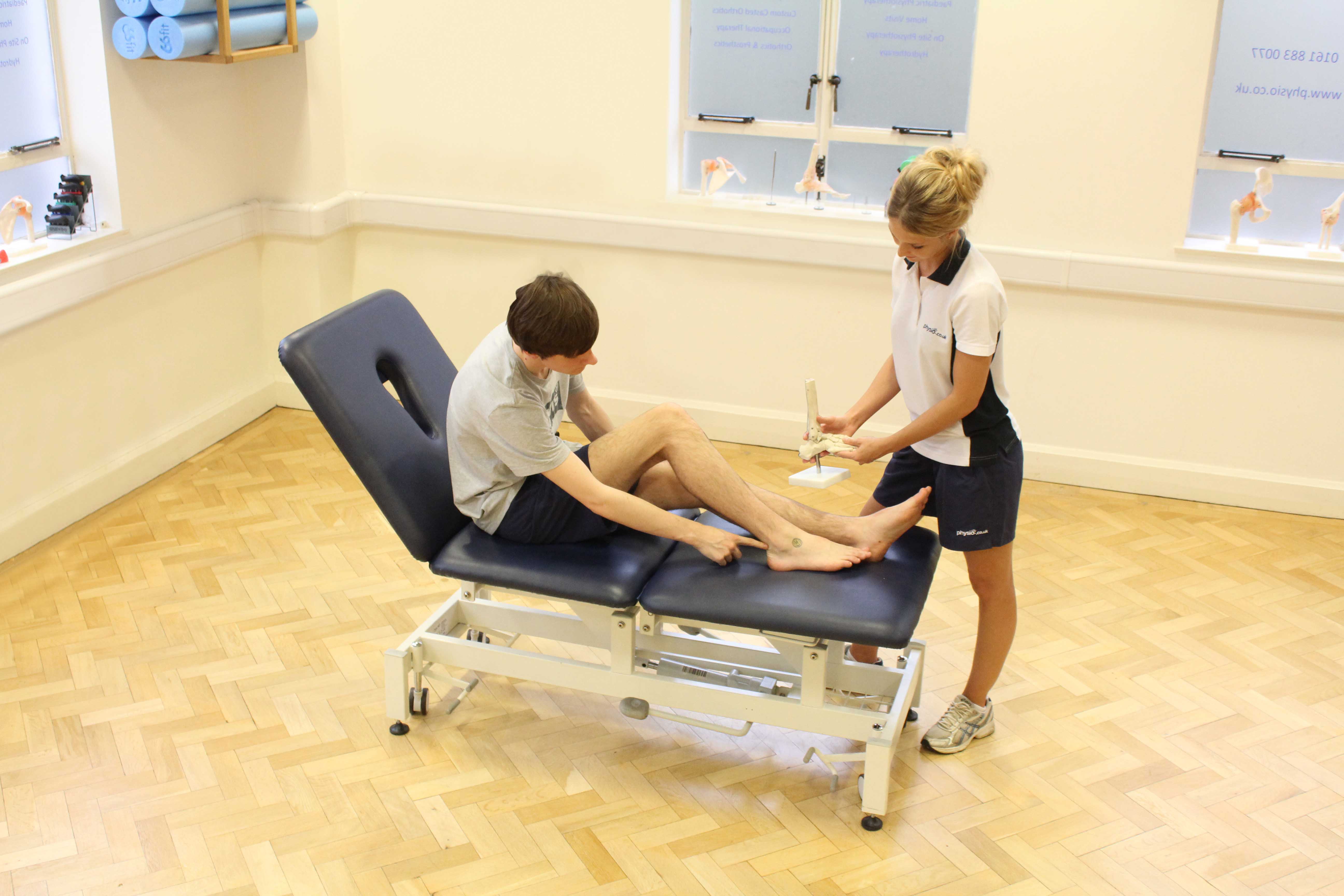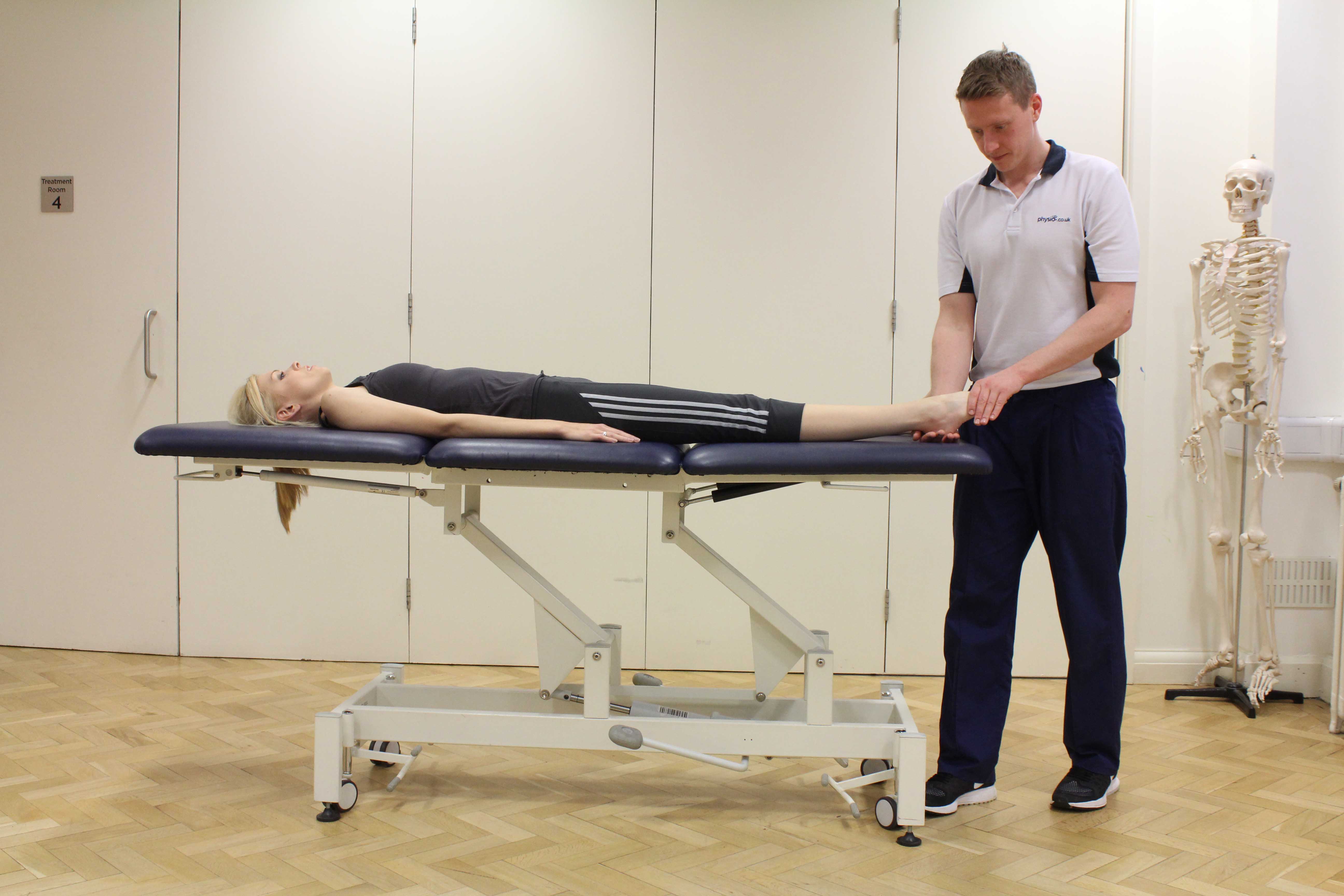Type 1: Stable fracture of the talus
Type 2: Displaced fracture of the talus which dislocates the joint in the ankle formed by the talus and calcaneus
Type 3: Displaced fracture of the talus which dislocates both the subtalar and talocrural joints
Type 4: Displaced fracture of the talus which dislocates the joint in the ankle formed by the talus and the navicular bone
If you have fractured your talus, you will notice some of the following symptoms:
- Pain when moving the ankle
- Crepitus(grating/ clicking noises) on movement if broken bone has gone into the joint
- Swelling
- Restricted range of movement
- Tender to touch the surrounding area
 Above: Therapist explaining ankle condition to client
Above: Therapist explaining ankle condition to clientPhysiotherapy prior to ORIF talus
The talus has a very poor blood supply and because of this following a fracture, it is common for the foot to be deprived of a blood supply following a fracture (avascular necrosis). Therefore it is essential that you participate in a full rehabilitation programme before and after surgery to minimise this type of complication. Before the operation you be placed on a waiting list and until then it is important to keep the strength and range of movement in the surrounding joints to give you the best chance of recovery and limit any further complications. At Physio.co.uk, we can provide a specially designed physiotherapy programme to be carried out before and after your operation. Physiotherapy treatment before surgery may include:
- Cryotherapy (ice treatment) to reduce swelling
- Compression techniques to reduce swelling
- Taping of the ankle to provide support, reduce swelling and minimise the risk of further injury
- Strengthening of other muscle groups in the lower leg
- Range of movement exercises in other joints
- Activities to maintain cardiovascular fitness including swimming and cycling
- Preparation for rehabilitation immediately after surgery
 Above: Soft tissue friction massage of the achilles tendon
Above: Soft tissue friction massage of the achilles tendonSymptoms after ORIF talus
Following your operation, you may experience some of the following symptoms which the physiotherapists at Physio.co.uk will help you to manage:
- Stiffness
- Swelling
- Temporary pain
- Temporary numbness and/or pins and needles around the foot and ankle if the nerves supplying the area have been disrupted during the operation
- A scar from where the surgeon has entered the joint
Physiotherapy following ORIF talus
Following your operation, you will be placed in an aircast boot or below the knee plaster and you will be unable to put weight through your foot (weight-bear) for at least 2 weeks. After 4-6 weeks you will be able to put some weight through it (partial weight-bearing) and you should be fully weight-bearing after 8 weeks.
 Above: Mobilisations and stretches applied to the connective tissues in the ankle
Above: Mobilisations and stretches applied to the connective tissues in the ankleWeeks 1-2
At this stage, your physiotherapy programme will consist of:
- Pain control
- Active exercise of the foot joints
- Cryotherapy treatment to reduce the swelling
- Elevation of the foot to reduce swelling
- Upper limb exercises
- Re-educating your gait (walking pattern) using crutches
- Teaching you simple techniques such as how to move from the bed to a chair without weight-bearing
Weeks 2-4
You may now be able to weight using just your toes (toe-touch weight-bearing) if you feel able. Physiotherapy at this stage will focus on:
- Simple strengthening and range of movement exercises
- Non-weight-bearing cardiovascular activity such as cycling in sitting and rowing
- You will also be taught how to walk using your crutches and the ‘toe-touch’ method
- Progression of your upper limb exercises
- Strengthening and stretching of the unaffected leg
- Continuing with Cryotherapy and elevation to reduce swelling
Weeks 4-6
You should now be able to partially weight-bear and begin a more intense physiotherapy programme at Physio.co.uk including:
- Range of movement and strengthening of the ankle joint
- Gentle mobilisations to increase movement at the joint
- Progression of cardiovascular activity levels
- Upper limb exercises
- Education on your walking pattern for partial weight- bearing
Weeks 6-10
After 8 weeks, your bone should have fully healed and your plaster will be removed. You should now be able to fully weight-bear and your programme at Physio.co.uk will include:
- Re-education of your normal gait
- Progression to more dynamic and functional strengthening and range of movement exercises
- Mobilisations of the ankle joint and other joints of the foot that may have become stiff
- Introduce swimming as a cardiovascular and non-weight-bearing activity
- Upper limb activity
- Maintaining activity levels of the unaffected leg
Summary
ORIF talus is a surgical procedure which is used to treat a fractured talus bone in the ankle. The operation involves realigning the broken bone and fixing the ends together with metal wires or pins. Success rates of the surgery are high if a good level of strength and fitness shown before the operation and this is maintained and improved following surgery. An individualised physiotherapy programme designed by Physio.co.uk can help you to optimise your recovery and return to your previous level of sport or activity as soon as possible. To book an appointment with one of the specialist physiotherapists at Physio.co.uk, call 0330 088 7800 today!

 0330 088 7800
0330 088 7800


































